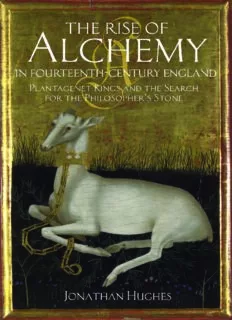
The rise of alchemy in fourteenth-century England : Plantagenet kings and the search for the philosopher's stone PDF
Preview The rise of alchemy in fourteenth-century England : Plantagenet kings and the search for the philosopher's stone
THE RISE OF ALCHEMY IN FOURTEENTH-CENTURY ENGLAND The Rise of Alchemy in Fourteenth-Century England Plantagenet Kings and the Search for the Philosopher’s Stone Jonathan Hughes Continuum International Publishing Group The Tower Building 11 York Road, London SE1 7NX 80 Maiden Lane, Suite 704, New York, NY 10038 www.continuumbooks.com © Jonathan Hughes 2012 All rights reserved. No part of this publication may be reproduced or transmitted in any form or by any means, electronic or mechanical, including photocopying, recording or any information storage or retrieval system, without prior permission from the publishers. First published 2012 British Library Cataloguing-in-Publication Data A catalogue record for this book is available from the British Library. EISBN: 978-1-4411-4278-8 Library of Congress Cataloging-in-Publication Data A catalog record for this book is available from the Library of Congress. Typeset by Newgen Imaging Systems Pvt Ltd, Chennai, India Printed and bound in India 99778811444411117788004466__PPrreelliimmss__FFiinnaall__ttxxtt__pprriinntt..iinndddd iivv 1122//66//22000000 99::3355::3300 AAMM W hite is specially employed in the celebration of the Passion of our Lord; though in the vision of St. John, white robes are given to the redeemed, and the four-and- twenty elders stand clothed in white before the great white throne, and the Holy One that sitteth there white like wool; yet for all these accumulated associations, with whatever is sweet, and honourable and sublime, there yet lurks an elusive something in the innermost idea of this hue, which strikes more of panic to the soul than that redness which affrights in blood. (Herman Melville, ‘The Whiteness of the Whale’, in Moby Dick) Contents L ist of illustrations v iii Acknowledgements ix Foreword x Part 1 Alchemy and the Occult in English Cultural and Political Life 1 Introduction: Alchemy and the Occult in England 3 2 The Origins of English Alchemy and Sources for the Study of Alchemy in Fourteenth-Century England 15 Part 2 The Astrology of the Earth: The Intellectual Impact of Alchemy in Fourteenth-Century England 3 Alchemy and Science and Philosophy 41 4 Alchemy and the Church 55 5 The Cultural Impact of Alchemy 69 Part 3 The Political Signifi cance of Alchemy 6 The Accession of Edward III 91 7 Alchemical Themes in the Kingship of Edward III 109 8 Richard II the Magus and Boy King 129 9 Richard II and the Occult 165 10 Conclusion: The Lancastrian Reaction 203 Notes 219 Bibliography 256 Index 274 Illustrations The Glastonbury thorn. Cruets and the heavenly dew. St John’s Church, Glastonbury 17 Hermes Trismegistus (Siena Cathedral) 21 The descent of Mercurial sperm into the primal ocean of chaos. From the Ripley Scroll 42 The dragon, sulphur. From the R ipley Scroll 82 Occult images in the border of Edward III’s copy of the Secreta Secretorum (BL Add MS 46680 Folio 3) 98 The Cosmati pavement, Westminster Abbey 107 Image of Alexander/Edward III and Aristotle (BL Add 47680 Folio 51v) 112 The sinister geomantic images of Rubella and Tristitia with Richard II’s thumb index (Bodley 581 Fo. 20v and 20r) 152 The W ilton Diptych showing Richard II and the three kings of the Epiphany. England under the guidance of the Virgin and the alchemical transformation of the kingdom. 183 Two geomantic shields from Richard II’s rosary showing prognostications with implications for the health of the queen and the political future of the king (Bodley 581 Folio 87) 194 Acknowledgements In the early stages of this book, while attempting to gain funding, I received much help in formulating research proposals from Peregrine Horden of Royal Holloway, London and Jeremy Catto of Oriel College, Oxford. They have both been kind enough to read and comment on the fi nal text. The British Academy has helped me with the expenses involved in consulting manuscripts with study grants. I also wish to thank the staff of The Bodleian Library, Oxford, the British Library, Lon- don and Cambridge University Library. I also wish to thank my parents, Robert Owen and Barbara Hughes. Their decision to emigrate to New Zealand exposed me to foreign travel at an early age, and while they may have transported me from the medieval infl uences of my infancy, Cuddington, Delamere Forest and Chester, this move would ultimately expose me to the inspiration of the late Valerie Flint at Auckland University. U nlike my two previous books, which were written in some diffi cult circum- stances, this one has been conceived and completed in a very happy and fulfi lled environment, and for this I am very grateful to my wife who has supported me throughout all the research and writing. We met at a conference on alchemy organ- ized by myself at the Wellcome Unit in the University of East Anglia in March 2002 and from that moment she has been a constant inspiration. Together we have trav- elled to many of the places associated with alchemy and the occult and she has shared all my enthusiasms and excitement as we visited the red and white springs at Glastonbury; the site of Merlin’s vision of the red and white dragons in Snow- donia; the Wilton Diptych in the National Gallery; the Cosmati pavements at West- minster Abbey, St Cecilia, Trastavere, Maria Maggiore, Rome and Hagia Sophia, Istanbul; the Grail sites in Languedoc; the treasury in San Marco, Venice; the Golden Lane and alchemical furnace at Prague Castle; and places associated with the birth of alchemy in the Nile Valley and with Muslim alchemy in Morocco. In addition she has carefully read the manuscript and made many valuable sugges- tions. This book is dedicated to her and to our son, Alexander, and to my children Venetia and Timothy who has helped me through many an ICT crisis.
Description: